

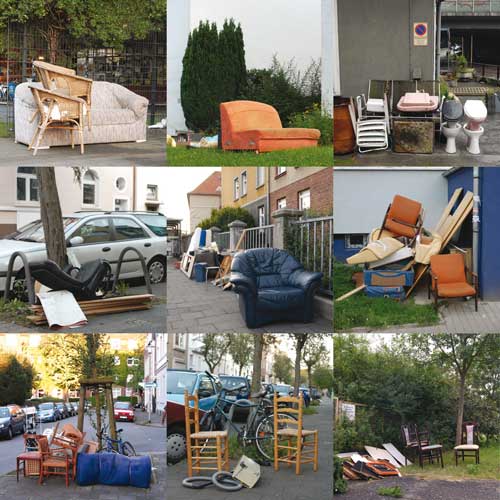
Project EXHIBITION [ETTE]
The notion of ‚ÄŇõexhibitionette‚ÄĚ signifies discarded and unneeded objects, sold in the streets in front of the houses of their owners. In this way structures resembling installations are created, constructed by anonymous authors, which enter a dialogue within and of the city space. These installations sometimes remain untouched for a few days though they often change their content and form after just a few hours due to the intrusion of ‚ÄŇõtreasure hunters‚ÄĚ.
During my travels in the countries of the European Union I searched for such ‚ÄŇõexhibitionettes‚ÄĚ and documented them in order to show this common phenomenon. Using some of them I built my own installations. I photographed them in such a way so as the space around them - in other words, the place where they were originally erected - would be clearly visible. While photographying them I came in interactive contact with the objects and tried to adapt to the situation both by what I was doing and the way I was dressed.
In this way a series of memorable self-portraits came into being, self-portraits with objects which have their own history - history to which I added a piece of my own life.
During my travels in the countries of the European Union I searched for such ‚ÄŇõexhibitionettes‚ÄĚ and documented them in order to show this common phenomenon. Using some of them I built my own installations. I photographed them in such a way so as the space around them - in other words, the place where they were originally erected - would be clearly visible. While photographying them I came in interactive contact with the objects and tried to adapt to the situation both by what I was doing and the way I was dressed.
In this way a series of memorable self-portraits came into being, self-portraits with objects which have their own history - history to which I added a piece of my own life.
ked Olszewski
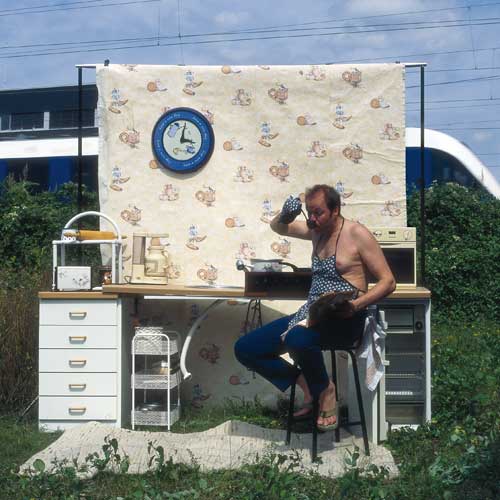
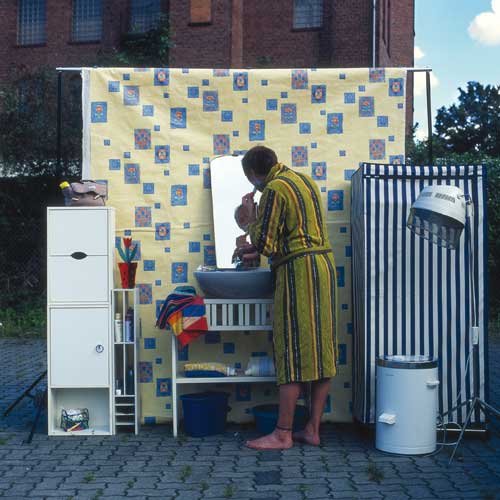
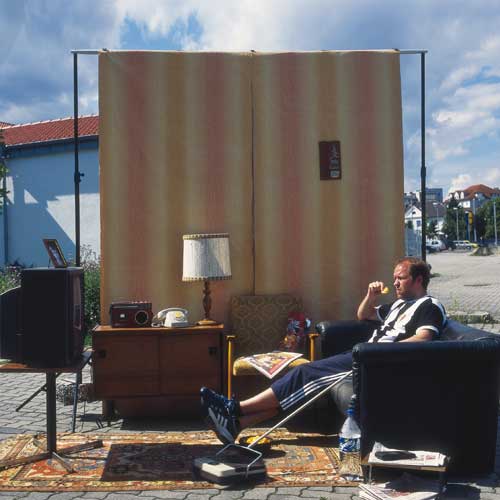
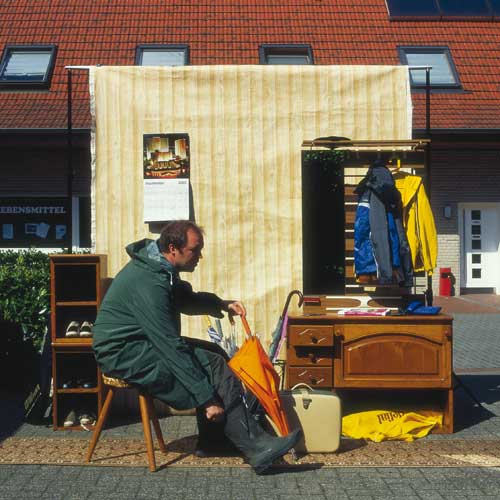
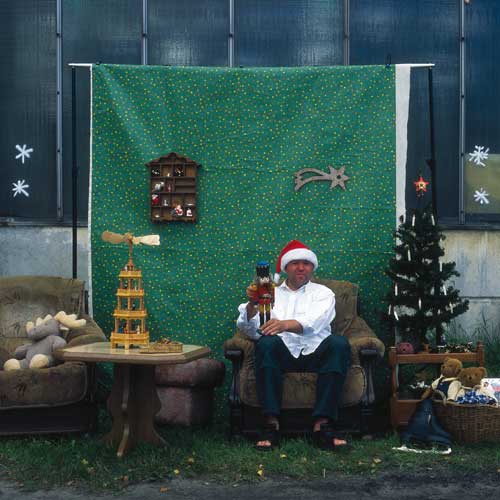

Exhibitions and Exhibitionettes
-
House Theatre without Walls
Exhibitions ‚Äď exhibitionettes; the first of these words sounds serious in Polish. It is associated with exhibitions of art, but also with a display, display in a store window in which products sold inside are as if advertised. And what about the term ‚ÄŇõexhibitionette‚ÄĚ? It is a ridiculous and derisive word, meaning an exhibition of poor art or an unimpressive display of commercial products. Finally it is a word that in Poland has gained another meaning recently, when the number of commercial objects produced in modern times became excessive. In this sense ‚ÄŇõexhibitonette‚ÄĚ replaces ‚ÄŇõa garbage dump‚ÄĚ.
In the 1980s shopping for and taking advantage of objects put on display during street and garage sales was treated with mixed feelings of both embarrassment and pride. After all it was thanks to those ‚ÄŇõexhibitionettes‚ÄĚ that during our travels to the then still exotic West ‚Äď exotic from the Polish point of view ‚Äď we could buy still quite decent goods, though on the other hand we did our shopping in garbage dumps of Europe. How is it today? Today second-hand shops became something common, and what is more, we live in the period of recycling, so if you are oriented ecologically, you are actually expected to make use of any old products so as not to intensify both the causes and effects of global warming.
Ked Olszewski confronts Polish myths and fears by means of his photographic projects. Earlier in his series ‚ÄŇõMade in Poland‚ÄĚ he travelled around the country, placing white and red objects within a black-and-white landscape. Today he travels all over Europe, watching the world built of trash and refuse which the inhabitants of New Europe can ‚ÄŇõrecycle‚ÄĚ best and bring back to life. However, ‚ÄŇõexhibitionettes‚ÄĚ are not only a sign of human ingenuity, but they also emphasize how easy it is to adopt a consumer lifestyle and begin to worship commercial products.
Olszewski stages the scene using discarded objects. He furnishes the space of streets and backyards with old tables, wardrobes and sinks. He himself plays the part of the inhabitant of those staged sets. He shaves in the bathroom and sits comfortably in the living room in front of the TV set. He does outdoors what we all usually do in our own cosy homes. His home, however, does not have any walls. Life goes on in the street; the sky is the roof of this home, its walls are an improvised curtain, but still the rhythm of our actions and everyday routine does not change. What does the word ‚ÄŇõhome‚ÄĚ mean, then? Olszewski domesticates the streets and gardens, marking neutral space with the objects introduced into it. In this sense ‚Äď taking possession of objects discarded by others ‚Äď he creates a ‚ÄŇõspace‚ÄĚ in which he leaves his trace.
Olszewski‚Äôs ‚ÄŇõexhibitionettes‚ÄĚ recall also another one of those earlier mentioned meanings ‚Äď as their stage-set arrangement reminds us of store-windows displays. The only difference is that the objects which the artist uses are not new ‚Äď on the contrary, they are obviously worn out and tattered. Perhaps then it is not so much a shopping mall decoration, but a museum? Where is the difference between the exhibitions held in both these institutions? The only difference seems to be the time when the objects were produced. The rhythm of contemporary life is marked by production, buying and consumming of commercial goods. We throw away what we have had enough of and what has not been used up and digested but became outmoded, passé. As Herman Lübbe remarked in the 1980s, our constant chase after novelties produces oldies and makes time pass much faster than normally. This means that the more we desire everything that is new, the deeper we are submerged in the world of the past and old-fashioned things. Possession of objects actually often plays a purely symbolic role, as it is not really important to have as many things as possible, but to have whatever is currently being promoted and advertised. What we find on the other side of the cult of commercial products is waste.
Olszewski‚Äôs ‚ÄŇõexhibitionettes‚ÄĚ are situated somewhere between two different meanings of photography. They are both documentary projects and creative ideas. They introduce serious contexts, provide ironic comments to them and demonstrate how much attention we devote to ordinary objects.
Marianna MichaŇāowska

View from exhibition
Next exhibition
7.03.2008
Copyright ©2008 Galeria FF ŇĀDK, ked Olszewski, Marianna MichaŇāowska